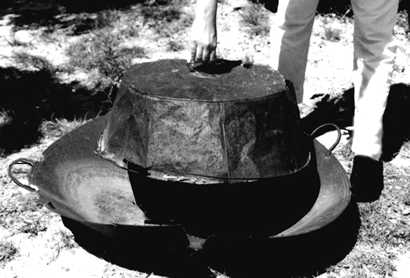|
Author
Mel Brown
on
"CHINESE
HEART OF TEXAS"
|
|
CHINESE
HEART OF TEXAS is 100 years of history
and 100 years of pride in the vibrant story of the early and modern
Chinese in Texas. No other group of people faced the unique struggles
and prejudices which confronted the Chinese as they chose to become
Americans. And no other group of people met those challenges as
well and as successfully as those travelers from the Orient.
San Antonio was the perfect place they might have found to adopt
as a new home as its own uniqueness fit them like a glove. The detailed
telling of that tale is here with many unpublished images of the
Chinese as they became Texans. Big stories and little ones all combine
to make a colorful mosaic of their trials and triumphs from being
undesirable aliens to kids in cowboy costumes. Then doctors, lawyers
and everything in between as the Chinese became true Americans in
every sense of the word.
|
|
|
Five
year old Washington Tom Lee shows off his official Roy Rogers cowboy
outfit and six-shooter cap pistol at his Texas Avenue home in San
Antonio about 1952. This youngster has become one of the city's most
respected physicians while his brother and a sister are also MDs,
one in Cal. the other in NYC.
Photo courtesy Dr. Washington Tom Lee |
Here
is a sampling of the material presented in CHINESE
HEART of TEXAS that will hopefully convey the sense of discovery
and fascination that I experienced during the book's research phase
which took over three years and thousands of miles to complete. During
that time I met average Americans who were born Chinese at a time
when that was uncommon in Texas. Most of them had stories that were
both familiar and unique, some that were especially worth hearing
and others that were not. I spent countless hours digging through
piles of books here in Austin among the stacks of the University of
Texas' incredible world class library system. More hours were spent
combing through head splitting, eye ball aching and mind numbing rolls
of Texas newspapers microfilm from the past 100 plus years.
Then there were the fun days spent walking the nearly forgotten and
long abandoned Chinese railroad worker's camps in West
Texas. About one hundred and thirty years ago those high desert
sites in the mostly barren Trans Pecos smelled of meals being cooked
never imagined by the few locals already living there. The chatter
of many voices was heard speaking a very different language than was
usual in those parts as the Asian men laid Southern Pacific track,
built bridges and dug tunnels connecting the second great transcontinental
railroad across America. |
 |
This broken wok
was left behind at an 1881 Chinese camp on a ranch near Langtry. Large
enough to cook for a dozen or more men, once broken, the cast iron
pan and lid were abandoned. Various workers from these camps became
some of the early Chinese to settle in San Antonio once the railroad
construction was completed in 1882.
Photo courtesy Mel Brown |
|
Fast
forward to just a few summers ago and we find my half Chinese daughter
Leanora stopping, kicking away some sand, then pulling on a busted
handle. She was soon surprised by the discovery of the lid from
an old wok. A few feet away, I was crawling around on hands and
knees only to find a funny little coin with a square hole in it
and a couple of buttons like I'd never seen before. It was possible
that they were dropped by the same daughter's Great-great-grandfather
who had also worked this line but certainly not as a tourist like
we were that day.
|
That
summer's road trip was a reward for my accepting the opportunity to
write this book which good fortune had laid before me a year earlier.
There have been other rewards and one must now be mentioned here because
it's the singular story that I always tell people who asked me why
I wrote CHINESE HEART OF TEXAS.
Now I'm quoting from the book's Preface because it had to be told
there too, "..... when beginning my formal research for the book,
I learned quickly that anyone who has written of Texas Chinese in
the past, relied on a 1941 masters thesis. It was written by one Miss
Amy Elizabeth Nims but I'd never heard of her until beginning my look
at this subject.
Having acquired a copy of Amy's thesis from Texas State University,
I was amazed by a coincidence found therein. It contains Amy's address
as of 1941 which was 1730 McKinley Ave. San Antonio, Tx. I subsequently
learned that this was her parent's home until the early 1950s. By
phenomenal chance, my parents bought that very house in 1960. I lived
there through my high school years, into college, then again occasionally
until I married a wonderful Chinese American girl named Lorraine Lee.
So begins this serendipitous Texas Chinese history." |
|
|
